Exoplanet Tour: Meet the 7 Earth-Size Planets of TRAPPIST-1
TRAPPIST-1: A system full of possibility
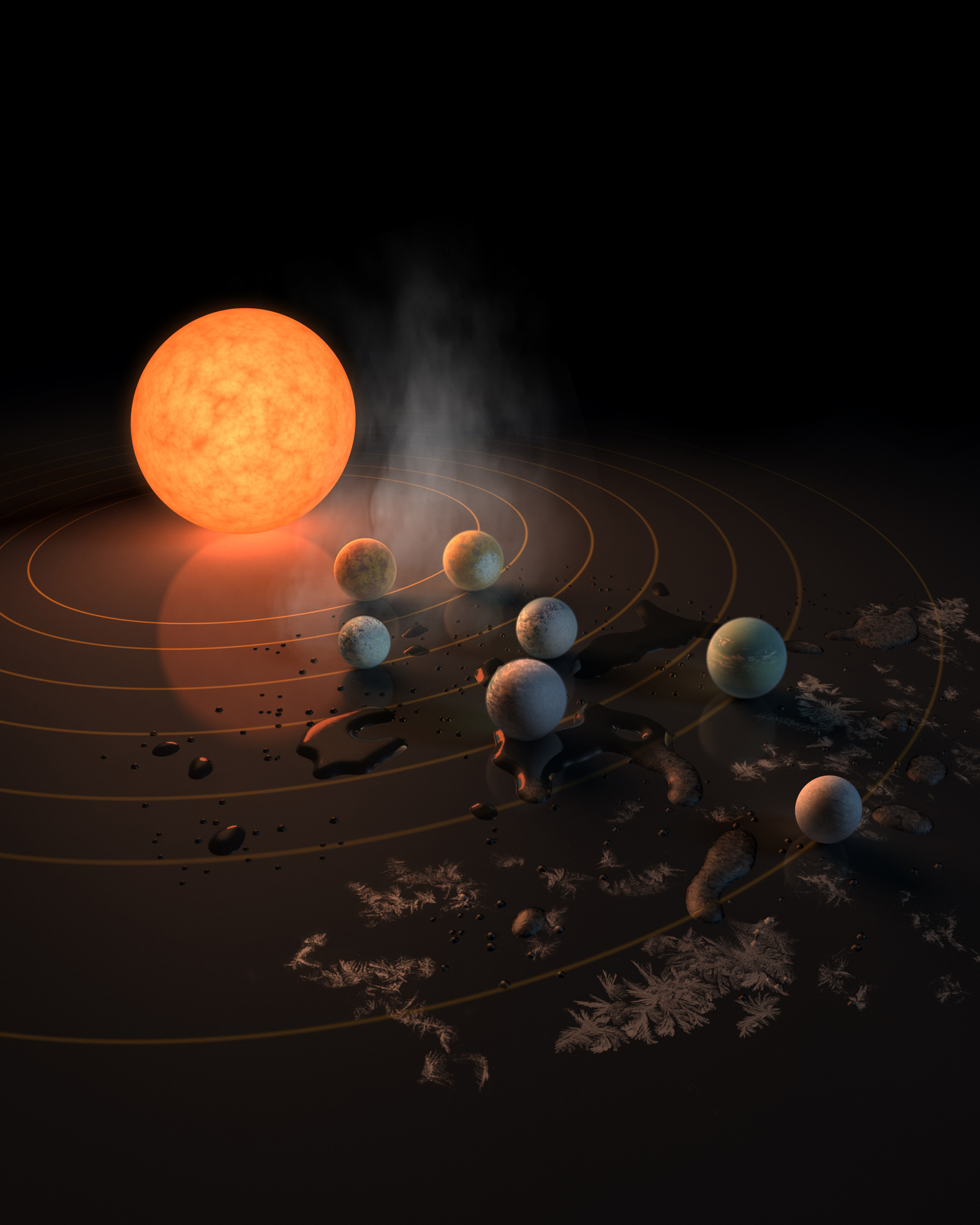
Astronomers have discovered the first known system to host seven Earth-size planets around one star, and it lies just 39 light-years away from our own solar system.
Using data from the TRAPPIST telescope in Chile and other ground-based telescopes, as well as NASA's Spitzer Space Telescope, the researchers identified the sizes, orbits and masses of most of the planets — suggesting that they all may be rocky, like Earth, and that three of them are in the habitable zone, where liquid water might linger and life as we know it could find a foothold.
Come along for a tour of the remarkable TRAPPIST-1 system. [Images: The 7 Earth-Size Worlds of TRAPPIST-1]
FIRST STOP: The star
TRAPPIST-1
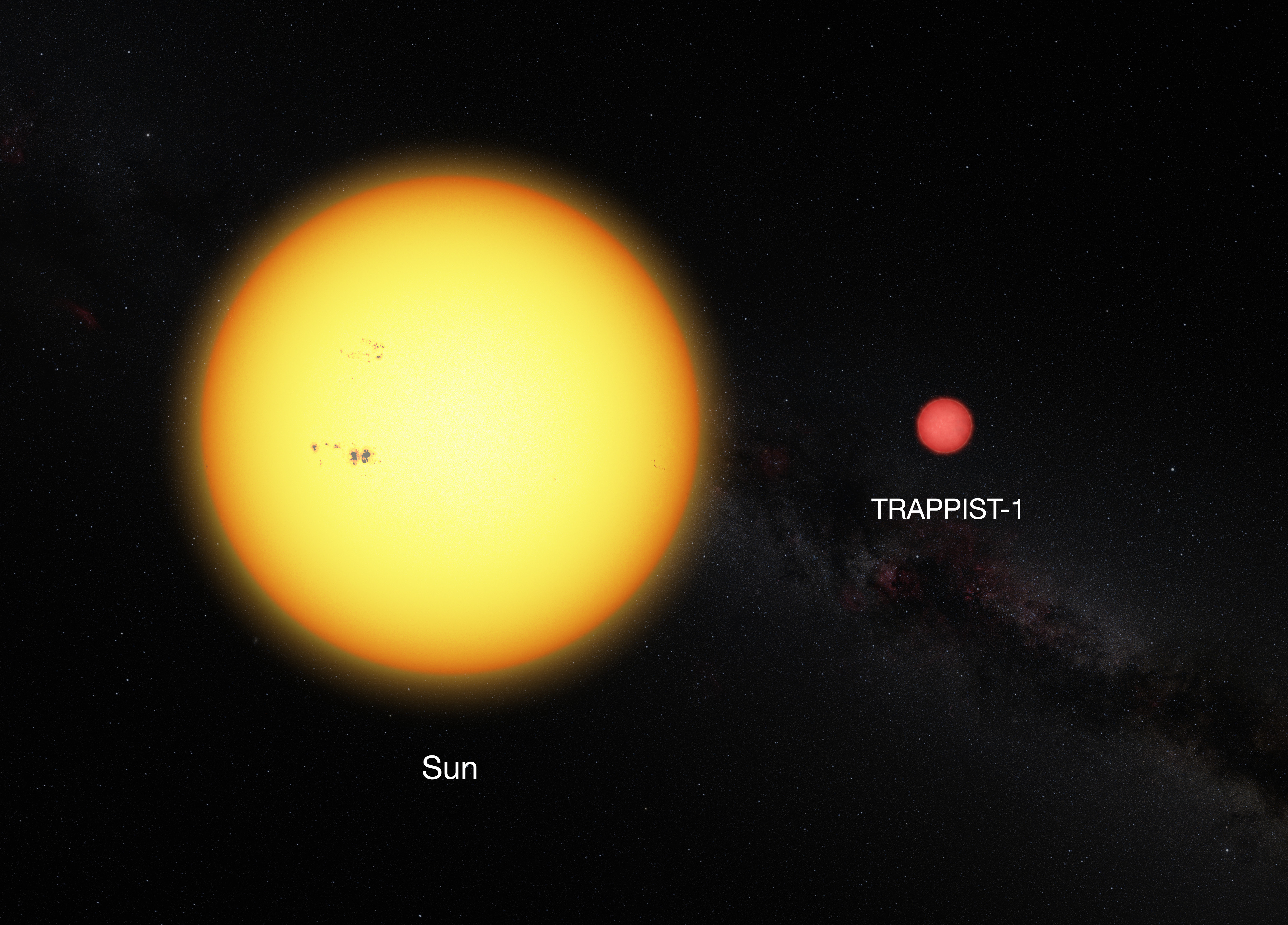
TRAPPIST-1 is a dim, cool star just a little bit bigger than Jupiter. It's about 8 percent as massive as the sun and shines just 0.05 percent as brightly as Earth's star. The planets researchers have spotted huddle up close, in very tight orbits that are all closer than Mercury's around the sun.
Most of the light TRAPPIST-1 releases is in infrared wavelengths, invisible to the human eye, which is why the Spitzer telescope, which measures in infrared, was the ideal tool to scope out more details about its orbiting planets. Ultracool dwarfs like TRAPPIST-1 are extremely long-lived because of their coolness; it could potentially keep burning for another 5 trillion years, long after the sun has run out of fuel. (The sun is about halfway through its project 10-billion-year lifespan.)
Dwarf stars make up about 75 percent of the Milky Way galaxy's stellar population. Planets in their habitable zones would appear to be too close, and in danger of blasts of radiation from these stars — but models suggest that some planets could withstand the punishing conditions to have conditions amenable to life, if their atmospheres and magnetic fields are strong enough. Because dwarf-star systems are so long-lived, they could also provide plenty of time for life to develop.
NEXT STOP: The innermost planet
TRAPPIST-1b
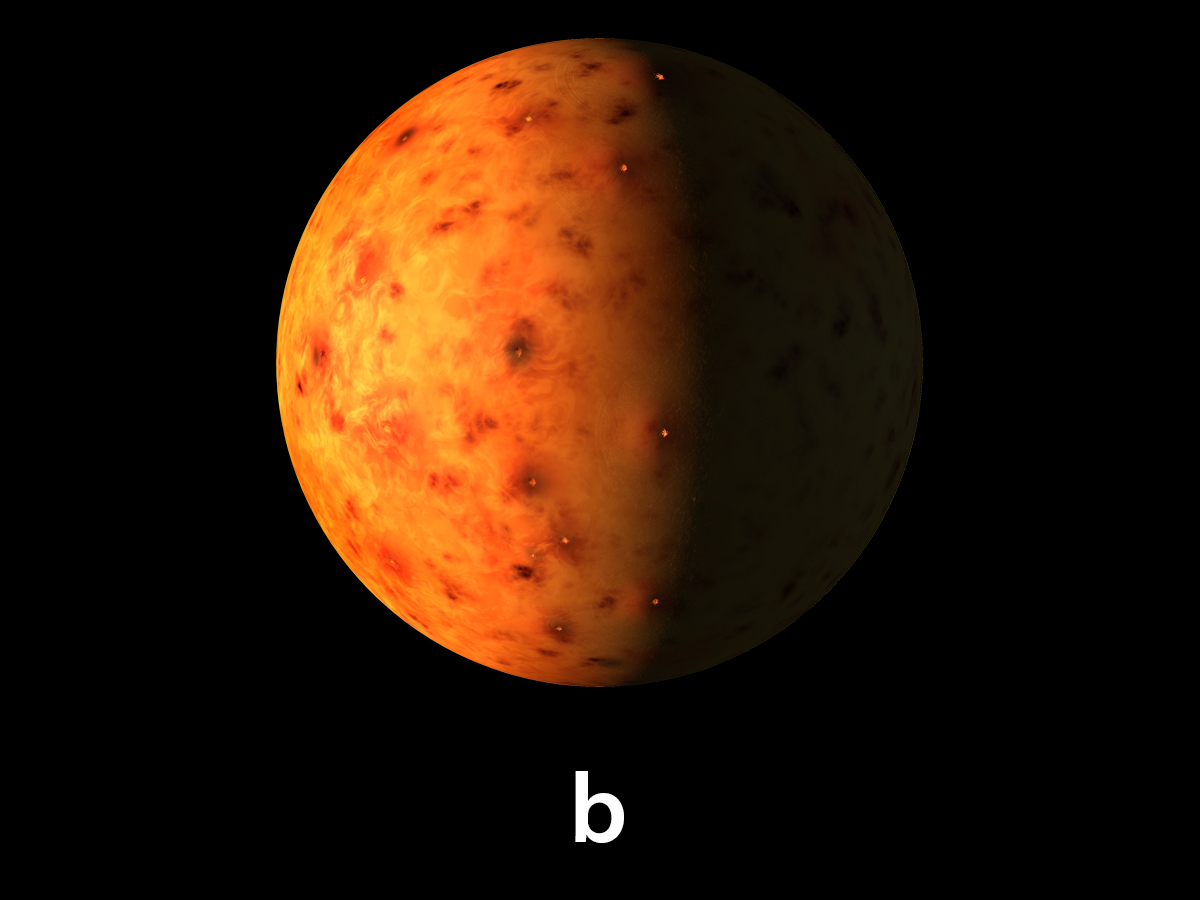
The innermost of the seven planets, TRAPPIST-1b, whips around the star once every 1.51 days, according to the most recent measurements (making that the equivalent of the planet's "year"). It orbits just 0.011 astronomical units (AU) away from the star, which is 1.02 million miles, or 1.64 million kilometers — 4.27 times the average distance from Earth to the moon. (1 AU is the average distance from Earth to the sun — about 93 million miles, or 150 million km.)
TRAPPIST-1b is about 1.09 times Earth's radius, and 0.85 times its mass, according to preliminary calculations — measurements that suggest it's likely rocky. Because of its closeness, 1b (and its sister planets) are likely tidally locked with their star, like the moon is to Earth, which means they orbit with the same sides facing it at all times. Despite the star's coolness, 1b is close enough to it that any water on the world would probably boil or sublimate off as steam.
NEXT STOP: Another warm world
TRAPPIST-1c
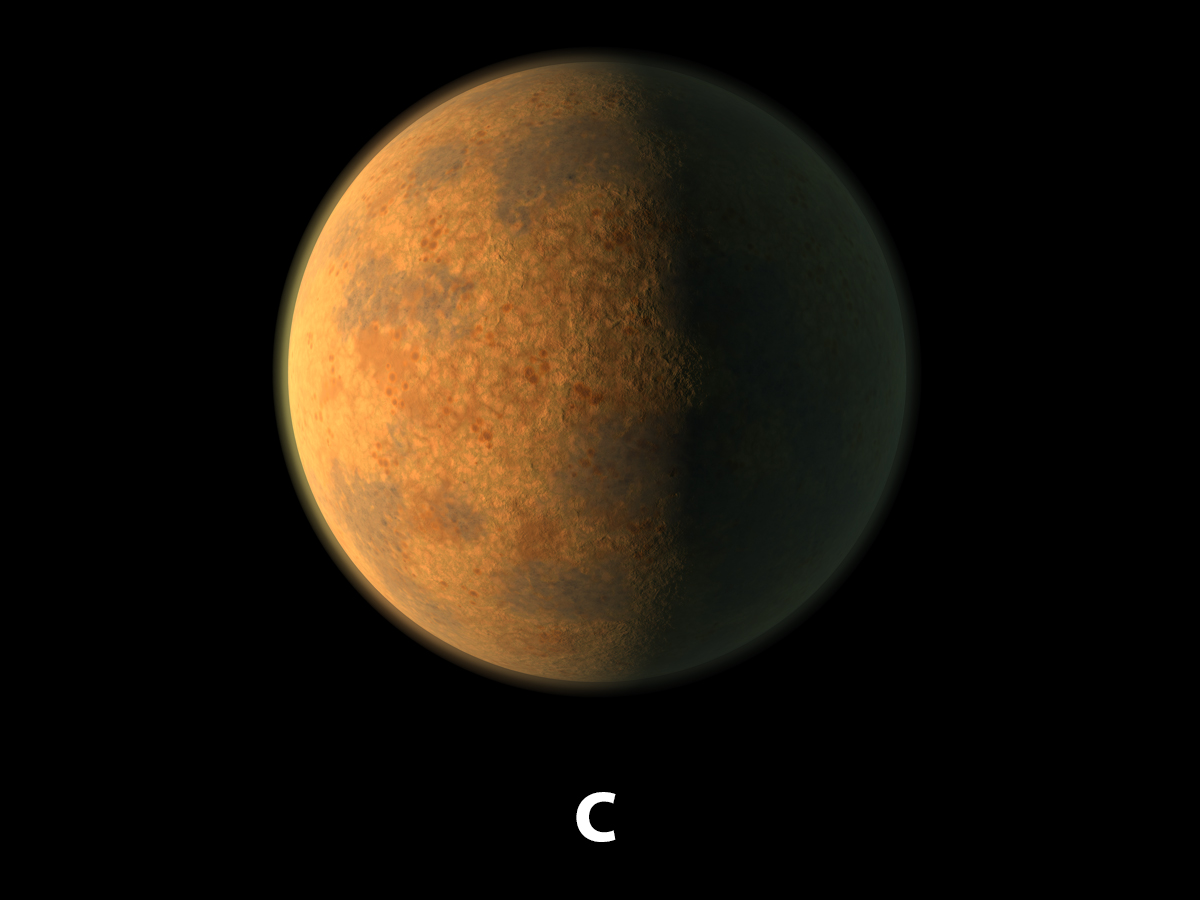
Like 1b, TRAPPIST-1c orbits close enough that liquid water likely doesn't exist on the planet's surface. It's 1.06 times Earth's radius and 1.38 times its mass, and it orbits around the star every 2.42 days. The planet orbits at a distance of 0.015 AU — that's 5.83 times the average Earth-moon distance.
Like TRAPPIST-1b, 1c was discovered orbiting TRAPPIST-1 last year, based on observations of the star's dimming as the planets passed by. It orbits five times for every eight orbits of the innermost planet — a "resonance" that suggests those planets could have moved inward from farther away at some point, researchers said.
NEXT STOP: The lightweight
TRAPPIST-1d
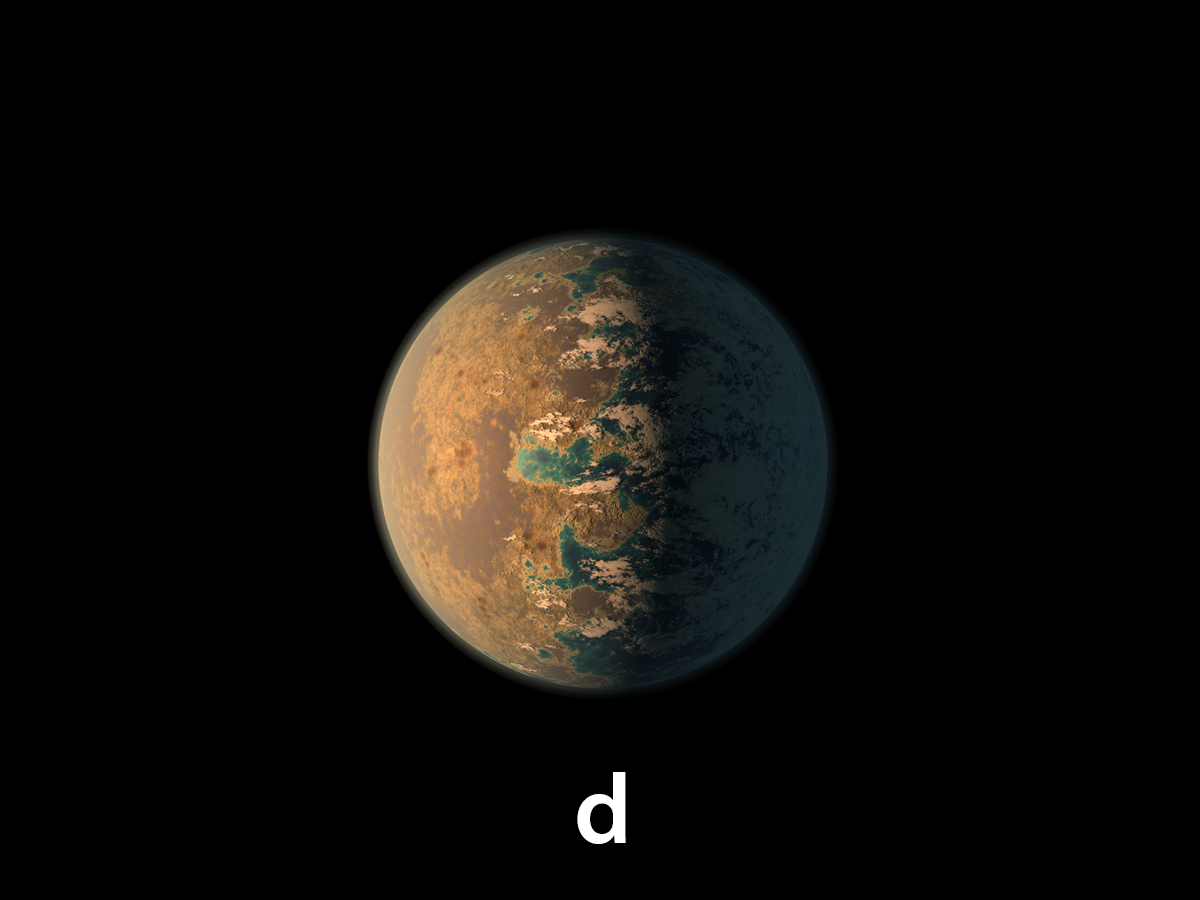
TRAPPIST-1d measures in at just 0.41 times the mass of Earth, making it the lightest planet with a known mass in the system (researchers aren't clear on the precise mass and radius of the farthest-out planet, 1h). The little planet has a radius 0.77 times the size of Earth's, and it orbits the star every 4.05 days at a distance of 0.021 AU (8.16 times the average Earth-moon distance).
Like its closer-in neighbors, the surface of 1d is likely too warm to sustain liquid water, astronomers said. It orbits three times for every eight orbits of the innermost planet.
NEXT STOP: Welcome to the zone
TRAPPIST-1e
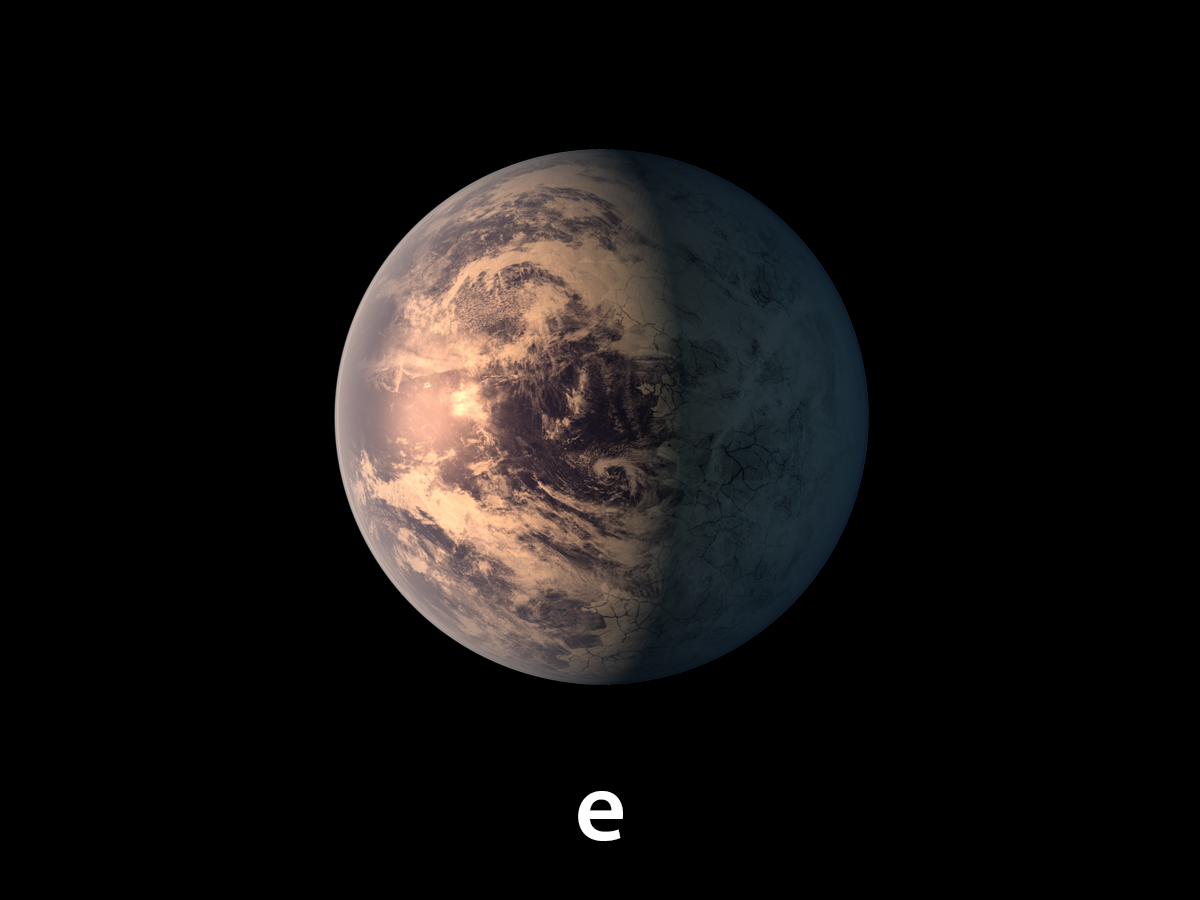
TRAPPIST-1e is the innermost of the seven planets to fall in the star's habitable zone — an orbit where liquid water could potentially exist on its surface, making it more amenable to life, given the right atmosphere. Even though 1e is likely tidally locked, like all the planets in the TRAPPIST-1 system, researchers said that it could still be potentially habitable if it has an atmosphere to even out the heat on the planet's surface. It receives about as much light from its star as Earth does from the sun, researchers said, suggesting that 1e could have similar temperatures.
1e orbits the star every 6.10 days, at a distance of 0.028 AU (10.8 times the average Earth-moon distance). It has a radius 0.92 times Earth's and is 0.62 times Earth's mass. NASA has mocked up an "Exoplanet Travel Bureau" poster for 1e, highlighting the planet's surface with its six glowing neighbors in the sky.
For every eight orbits of 1b, 1e orbits twice. The planets' resonant orbits — many of which have integer ratios with one another — may suggest that the planets traveled inward from farther out in the system. Farther out, there would be more ice present; thus, the configuration could mean the planets are more likely to have water readily available.
NEXT STOP: Stunning views
TRAPPIST-1f
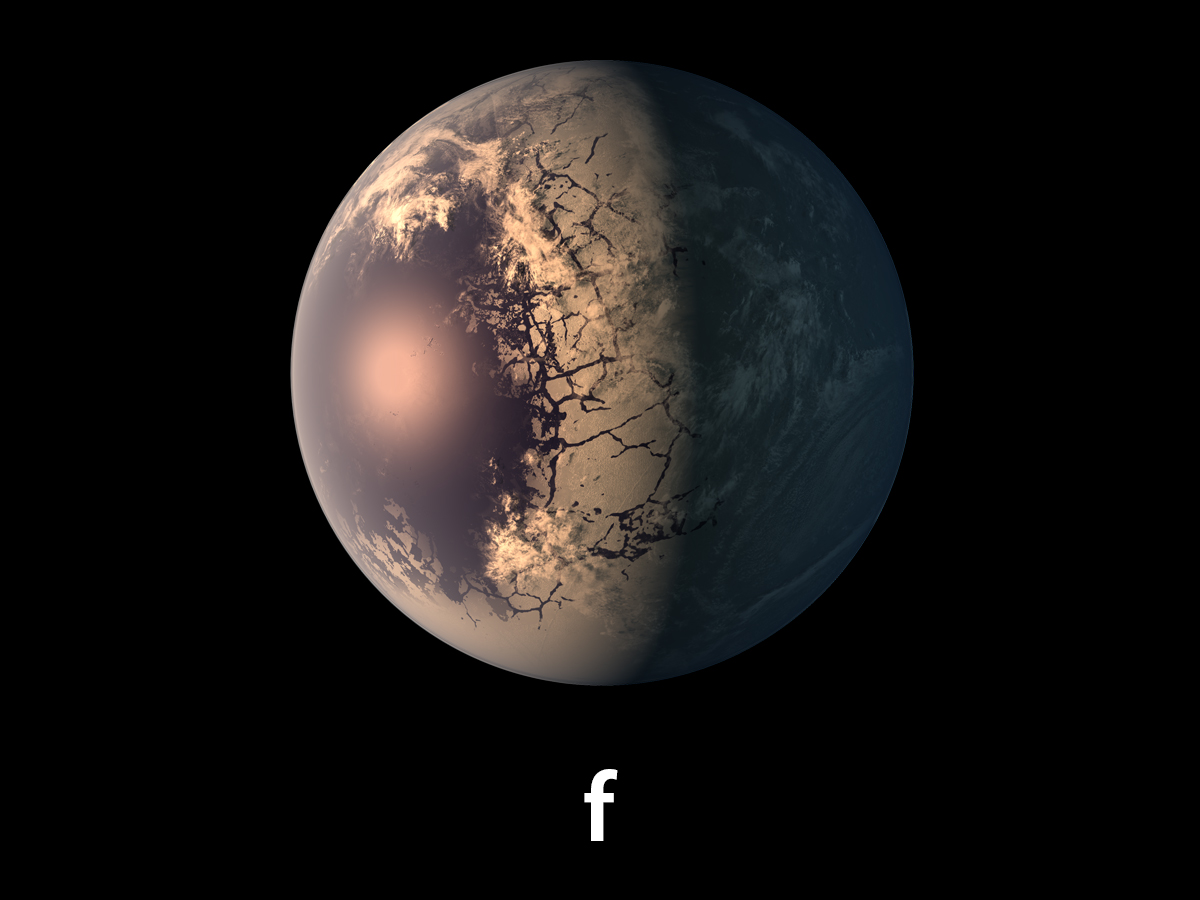
From the surface of TRAPPIST-1f, an intrepid space traveler would see a beautiful array of neighboring planets if skies were clear. 1f is also in the star's habitable zone. The nearby 1e would appear about the size of the moon from Earth, according to NASA’s Jet Propulsion Laboratory, and the dim star would appear about three times larger than the sun in Earth's sky. (Many neighboring planets should be visible from each planet's surface, atmosphere permitting.)
1f orbits the star every 9.21 days — positively leisurely compared to the inner planets, although still much more quickly than the solar system planet with the shortest year: Mercury orbits the sun every 87.97 days. The planet's orbit is 0.037 AU, which is 13.3 times the average Earth-moon distance; it's 1.04 times Earth's radius and 0.62 times Earth's mass. It orbits 1.33 times for every eight orbits of 1b.
1f is potentially water-rich, researchers said, and receives about the same amount of starlight as Mars gets from the sun.
NEXT STOP: Getting chilly
TRAPPIST-1g
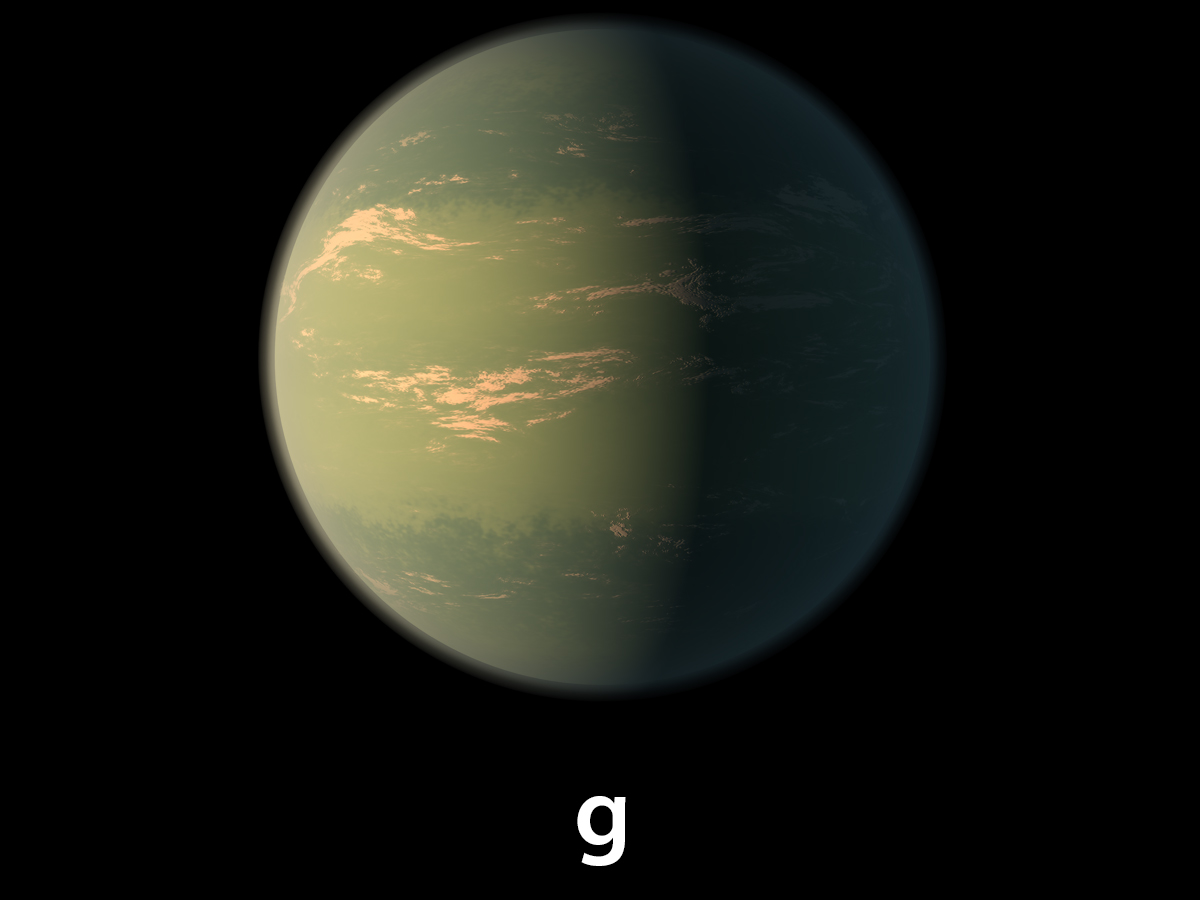
TRAPPIST-1g is right on the outermost edge of what researchers think is the habitable zone around the star — getting chilly, but likely not too cold for liquid water to exist on the surface. 1g orbits the star every 12.35 days at a distance of 0.045 AU (17.4 times the average Earth-moon distance). The planet is 1.13 times Earth's radius — the largest of the measured planets — and is 1.34 times its mass.
1g receives about the same amount of starlight as somewhere in our solar system between Mars and the asteroid belt.
It's worth stressing here that the habitable zone for any planetary system is hardly set in stone. The contours of the zone depend on a planet's atmospheric composition, for example. And the gravitational tug the TRAPPIST-1 planets exert on each other could potentially warm them from within, changing the habitable zone around the star by making planets farther out able to sustain liquid water. The radiation from the star could also affect where liquid water can persist, researchers said.
NEXT STOP: The wild card
TRAPPIST-1h
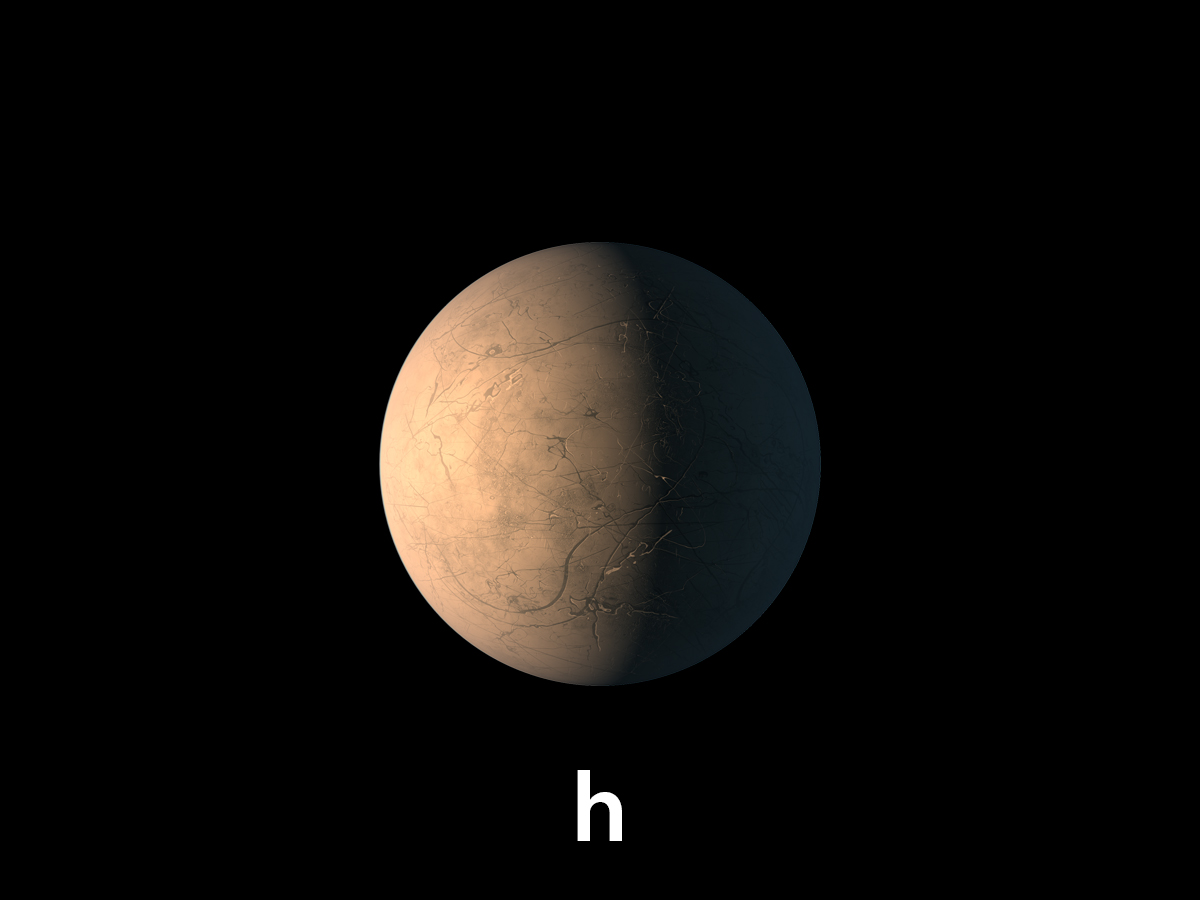
TRAPPIST-1h is the farthest out and least-known of the planets — researchers think it has an orbit lasting about 20 days at about 0.06 AU from the star (23.3 times the average Earth-moon distance), but the Spitzer telescope spotted it passing by the star only once, so its stats are much less certain than its neighbors. It appears to be 0.76 times Earth's radius, and its mass is unknown. It should be outside the habitable zone, with an icy rather than watery surface.
Many researchers are turning telescopes toward the TRAPPIST-1 system, whose known planets all fit easily within Mercury's orbit around the sun, so we will soon learn much more about them (including, with the help of NASA's $8.8 billion James Webb Space Telescope, which is set to launch late next year, potentially their atmospheres) — and even if they have any neighbors farther out, orbiting in the dim twilight beyond the cool star's view.
Email Sarah Lewin at slewin@space.com or follow her @SarahExplains. Follow us @Spacedotcom, Facebook and Google+.
Join our Space Forums to keep talking space on the latest missions, night sky and more! And if you have a news tip, correction or comment, let us know at: community@space.com.
Get the Space.com Newsletter
Breaking space news, the latest updates on rocket launches, skywatching events and more!

Sarah Lewin started writing for Space.com in June of 2015 as a Staff Writer and became Associate Editor in 2019 . Her work has been featured by Scientific American, IEEE Spectrum, Quanta Magazine, Wired, The Scientist, Science Friday and WGBH's Inside NOVA. Sarah has an MA from NYU's Science, Health and Environmental Reporting Program and an AB in mathematics from Brown University. When not writing, reading or thinking about space, Sarah enjoys musical theatre and mathematical papercraft. She is currently Assistant News Editor at Scientific American. You can follow her on Twitter @SarahExplains.
